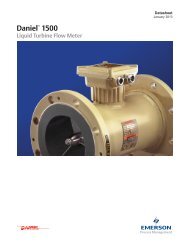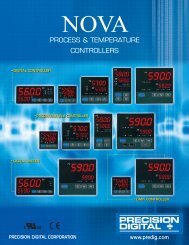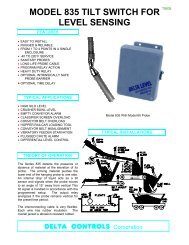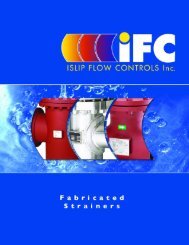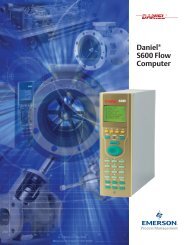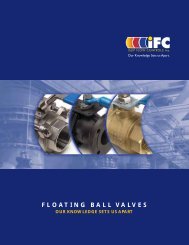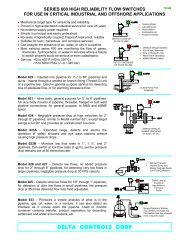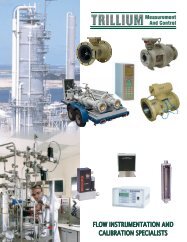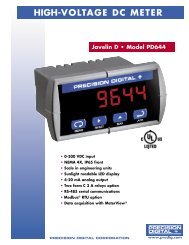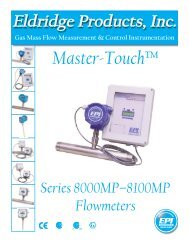You also want an ePaper? Increase the reach of your titles
YUMPU automatically turns print PDFs into web optimized ePapers that Google loves.
13428 TC IFC <strong>Check</strong> 11/10/06 8:46 AM Page 4<br />
Dual Disc <strong>Check</strong> Valve Design Features<br />
Dual Disc <strong>Check</strong> Valve Design Features<br />
Wafer Dual Disc Design Advantage<br />
The short face to face design inherently makes this check<br />
valve significantly lighter 1 . The valve is designed to fit between<br />
two flanges and requires no flanges of its own. The dual disc<br />
check valve can be installed in any position as the spring aids<br />
in keeping the valve closed 2 . These features allow you to<br />
design your piping layout in the most efficient and least<br />
expensive fashion.<br />
1 10% of the weight of a conventional swing check<br />
2<br />
Consult factory for vertical downward flow<br />
Shock Bumpers<br />
An integral cast bumper (Fig. 1) is present on all IFC Dual<br />
Disc <strong>Check</strong> <strong>Valves</strong> (Except class 125 lb). The bumpers can be<br />
found on both discs, which meet when the valve reaches a<br />
fully open position. This design feature prevents the discs from<br />
pressing against the stop pin and eliminates leverage that<br />
would cause unnecessary stresses and wear. The purpose of<br />
the stop pin is to prevent over-travel of either disc, which<br />
would result in valve failure.<br />
Resilient Seat<br />
The basic design of the IFC Dual Disc <strong>Check</strong> Valve is<br />
illustrated in Fig. 2. This seal is chemically bonded using<br />
specially designed adhesives that provide rubber tearing bonds<br />
throughout the operating range of the seat material. In case of<br />
resilient seat failure, the IFC design permits the discs to float<br />
and make contact with the metal surface the seats were<br />
adhered to. This feature allows the valve to function even if<br />
the resilient seat is not present. IFC also has available a seat<br />
design illustrated in Fig. 3. This design results in a controlled<br />
seat squeeze and provides a metal-to-metal backup seal (Fig.4).<br />
Fig. 2<br />
Retainerless Option<br />
The IFC Series DR Dual Disc <strong>Check</strong> Valve incorporates a retainerless hinge pin design, such that no screwed plugs are required<br />
in the assembly of the valve. This design feature eliminates the potential leak path to atmosphere associated with many<br />
competitors’ designs. The IFC Series DR utilizes Allen set screws to retain two pin guides that house both the hinge and stop<br />
pins. This allows for quick disassembly of the valve without the use of force or special tools other than an Allen wrench.This<br />
unique feature ensures that today’s and the future’s valve fugitive emission requirements are met.<br />
Fig. 3<br />
Fig. 1<br />
Fig. 4<br />
Minimal Seat Wear<br />
The IFC Dual Disc <strong>Check</strong> Valve was designed to eliminate the possibility of seat wear caused by friction at the heel of the dual<br />
discs while maintaining low back pressure sealing capabilities. The clearance between the body, disc and hinge pin results in the<br />
discs cracking open at the heel location first (Fig. 5). When the valve opens the heel does not drag across the seating surface and<br />
cause wear (Fig. 6). As the valve closes, the spring will take the toe of the disc into the seating surface first, while the line back<br />
pressure will force the heels and hinge pin back to the seat to complete the seal (Fig. 7).<br />
Fig. 8<br />
Standards of Construction<br />
Component<br />
Standard<br />
Pressure Boundary Design ASME B16.34<br />
Dimensional Criteria<br />
ASME B16.1, B16.42, B16.47, API-594<br />
Pressure / Temp. Rating ASME B16.1, ASME B16.34<br />
Visual Examination<br />
MSS SP-55<br />
Pressure Testing<br />
API-598<br />
Fig. 5 Fig. 6<br />
Fig. 7<br />
3 Tel. 905-335-8777 Fax. 905-335-0977 Toll Free Tel. 1-866-872-0072 Toll Free Fax. 1-866-872-0073<br />
Tel. 905-335-8777 Fax. 905-335-0977 Toll Free Tel. 1-866-872-0072 Toll Free Fax. 1-866-872-0073<br />
4




